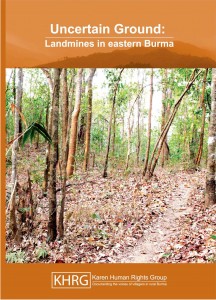Uncertain Ground: Landmine Use in Eastern Burma
By Karen Human Rights Group • May 22, 2012 This report focuses on field information received between January and December 2011. Key updates relating to the use of landmines in 2012 were also included, however due to the sheer volume of information that KHRG regularly receives, all field information received since the beginning of 2012 has not yet been closely analysed. For example, during 2011 alone, community members working with KHRG collected a total of 1,270 oral testimonies, sets of images and documentation written by villagers, including: 523 audio-recorded interviews, 220 incident reports, 84 situation updates, 125 other documents written by villagers, 111 sets of photos and video amounting to a total of 12,517 images, and 207 written orders issued by civilian and military officials. Interviewees included both village leaders and persons not in positions of leadership, as well as men, women and youths. KHRG is committed to interviewing villagers from all ethnic groups within its research areas. The majority of villagers interviewed belong to different sub-ethnicities of Karen, however interviews were also conducted with other ethnic groups, including Burman, Pa’O, Mon, Chin, Karenni, Arakan and Shan villagers.
This report focuses on field information received between January and December 2011. Key updates relating to the use of landmines in 2012 were also included, however due to the sheer volume of information that KHRG regularly receives, all field information received since the beginning of 2012 has not yet been closely analysed. For example, during 2011 alone, community members working with KHRG collected a total of 1,270 oral testimonies, sets of images and documentation written by villagers, including: 523 audio-recorded interviews, 220 incident reports, 84 situation updates, 125 other documents written by villagers, 111 sets of photos and video amounting to a total of 12,517 images, and 207 written orders issued by civilian and military officials. Interviewees included both village leaders and persons not in positions of leadership, as well as men, women and youths. KHRG is committed to interviewing villagers from all ethnic groups within its research areas. The majority of villagers interviewed belong to different sub-ethnicities of Karen, however interviews were also conducted with other ethnic groups, including Burman, Pa’O, Mon, Chin, Karenni, Arakan and Shan villagers.
In order to systematically analyse data and draw conclusions regarding the use of landmines in eastern Burma, seven KHRG staff analysed English translations of a total of 603 oral testimonies and pieces of written human rights documentation received between January 2011 and May 2012, as well as 141 sets of images.12 Of these, 119 described events, raised concerns or dealt with issues related to the use of landmines in eastern Burma.
Download the full report here.
Tags: Crimes against humanity, Human Rights, Karen Human Rights Group, Karen State, LandminesThis post is in: Crimes Against Humanity, Human Rights
Related Postsလားရွဴိးၿမိဳ႕နယ္ မိုင္းေယာ္ေဒသခံမ်ားအား သတ္ျဖတ္ခဲ့သည့္ ျမန္မာ့ တပ္မေတာ္၏အၾကမ္းဖက္လုပ္ရပ္ကို ကန္႕ကြက္ရႈတ္ခ်သည့္ သေဘာထားထုတ္ျပန္ခ်က္
2016 Trafficking in Persons Report – BURMA: Tier 3
TRAINED TO TORTURE: Systematic war crimes by the Burma Army in Ta’ang areas of northern Shan State (March 2011 – March 2016)
တကၠသိုလ္ေက်ာင္းသား ဂြမ္ဆိုင္းေအာင္အား၊ အစိုးရစစ္တပ္၏ တပ္သားတစ္ဦးမွ ကခ်င္ျပည္နယ္ ျမစ္ၾကီးနားျမိဳ႕တြင္း၌ ပစ္ခတ္သတ္ျဖတ္ျခင္းအေပၚ ေက်ာင္းသားလူငယ္ထုႏွင့္ အရပ္ဘက္လူမႈအဖြဲ႔အစည္းမ်ား၏ သေဘာထားထုတ္ျပန္ေၾကျငာခ်က္
ေအာင္ေဇယ်ာတပ္ခဲြတြင္ တာ၀န္ထမ္းေဆာင္ေနေသာ ဗုိလ္ၾကီးတဦးမွ အမ်ိဳးသမီးတဦး၏ ရင္ဘတ္ႏွင့္ နားထင္ကုိ ေသနတ္ျဖင့္ ေၾကိမ္းၾကိမ္ေထာက္ခါ ပစ္ခတ္ရန္ခ်ိန္းေျခာက္မႈႏွင့္ ပတ္သက္၍ ကူကီအမ်ိဳးသမီးစင္တာမွ သေဘာထားထုတ္ျပန္ေၾကညာခ်က္









 All posts
All posts